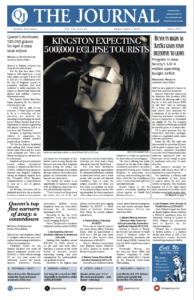Beirut, a city where war never ends, is at the centre of the Images of Resistance showcase located at the Art and Media lab in the Isabel Bader Centre.
Rena Karanouh’s, PhD ’23, artwork and dissertation titled Last Out of Beirut Turn off the Light are front and centre in the gallery. The themes of reclamation of public space in Beirut and active resistance are fundamental to the art.
With a background in graphic design and illustration, Karanouh’s work integrates the written word, interviews, and storytelling as part of oral history creation.
“It was very much about storytelling and narratives and [people’s] memories, and the places—mostly the public spaces—where they remembered everything about their childhood, or everything that made Beirut—Beirut for them,” Karanouh said in an interview with The Journal.
In the gallery, political criticisms and giving her own opinion on specific issues was present in combination with showing public spaces which can be private.
“It all has to do with my research, which was about how public spaces form communities and how there’s no community if there’s no public space, and how public spaces are used by the people and how the political establishment uses the public space,” Karanouh said.
Speaking to the Lebanese context, public space is important due to the civil war which spanned from 1975 and ended in 1990. Karanouh said people were divided, which was visible through them living in enclaves. The only place where people mixed was public spaces.
“The resistance part comes in Lebanon when the public space is expropriated or exploited by the governing bodies—then you create a resistance to stop it,” Karanouh said.
“My chapters are basically examples of where the people stood up and resisted the policies of the political class and the governing bodies.”
The gallery shows people can rise against the political class and the power associated with them. The realities of a political ruling power and dynasties are shown, as are the Lebanese people fighting back against them.
“People did stand up, and people did form communities and different people from different areas, different geographies, different classes, different sects, they all formed the community to fight them,” Karanouh said.
The art is meant to make people aware that you can fight the strong political class and resist policies. In Karanouh’s dissertation, there is acknowledgment of those who lost these battles, but she said it’s also important to acknowledge the many who have won.
“The public spaces are still public spaces only because people stood up and said, ‘no, we disagree with what you did.’ We want it to remain the way we want it to remain, you know, you can’t take it away from us,” Karanouh said.
In one piece of art, the militia leaders’ guns evolve into pens—the guns become self-fulfilling laws allowing the individual military leaders to profit and make gains.
“The governing elites are doing exactly what they did after the war, which was basically erase any semblance of the war so nobody can remember there was a war so that they could be tried and made accountable for all their war crimes,” Karanouh said.
According to her, the same tactic is being used with the recent explosions of the silos. An illustration depicts government neglect and the attempt to gloss over the catastrophic events of that day.
“You need to keep the silos up, but the political class don’t want them to stay up,” Karanouh said.
“They kept the fire burning in them, because the weight of the corn was still there. In the summer, they kept a fire burning for two months.”
Reflecting on the work, Karanouh said her dissertation gallery wouldn’t have been possible without anonymous contributions from folks from Palestine who helped after she didn’t have the funds and didn’t receive grants to print her art pieces.
“[My supervisor Professor Sylvath Aziz] talked to a friend about my case that I couldn’t make the exhibition, because I don’t have any funding […] Those friends said this work was important,” Karanouh said.
“They sent me an envelope with a beautiful note inside. They were saying, we are your Palestinian friends from Nablus, and we feel it’s very important that we fund this.”
Karanouh said she was ecstatic and that it put her faith back in humanity.
“[They] gave funds for an exhibition for a person they’ve never met, they’ve never talked to. It was just amazing […] And that’s how the exhibition happened because of these beautiful Palestinian people from Nablus who decided to fund me.”
Tags
All final editorial decisions are made by the Editor(s)-in-Chief and/or the Managing Editor. Authors should not be contacted, targeted, or harassed under any circumstances. If you have any grievances with this article, please direct your comments to journal_editors@ams.queensu.ca.

